A Probabilistic–Geometric Approach for UAV Detection and Avoidance Systems †
Abstract
1. Introduction
- The proposition of a new collision detection and avoidance algorithm that achieves the following properties:
- -
- Multiple irregularly shaped obstacles and moving intruders can be considered in tactical de-confliction;
- -
- Uncertainties in UAVs’ relative position are considered in determining the collision avoidance manoeuvre by utilising the collision probability;
- -
- Minimum separation for safety can be analytically proven by differential geometry concept.
- Validation of performance of the proposed algorithm using analytical and numerical analysis.
- Demonstration of the safety, scalability, and efficiency of the proposed approach in comparison with other well-known benchmark algorithms.
2. Problem Formulation
- The relative position error with the intruder UAVs satisfies the Gaussian distribution. This assumption was validated by the empirical studies and used in many related works [19].
- There exists no correlation between the estimated positions of UAVs. In the scenarios considered in this paper, it is assumed that the UAV estimates the positions of intruders and its position using onboard sensors. Under these scenarios, it is reasonable to assume that the estimated positions of UAVs are uncorrelated. This assumption makes the covariance matrix of the relative position estimates the summation of individual UAVs’ covariance matrices [17].
- The ground speeds of the vehicle and intruders are assumed to be constant at V and , respectively.
- the intruder i if ;
- the polygonal obstacle j if .
- the intruder i if ,
- the polygonal obstacle j if ;
3. Collision Avoidance Algorithm
3.1. Collision Probability Computation
3.2. Conflict Detection Method
3.3. Conflict Resolution Method
3.4. Minimum Separation Analysis
| Algorithm 1 Collision Avoidance Algorithm |
| Input:,,,,,,,. |
| Output:. |
| 1: for each moving intruder UAV i do 12: ← Equation (8); |
| 2: if then 13: end if |
| 3: ←Equation (4); 14: end for |
| 4: ←Equation (3); 15: ←Equation (10); |
| 5: ←Equation (6); 16: ifthen |
| 6: Equation (5); 17: ←Equation (12); |
| 7: end if 18: ←Equation (14); |
| 8: end for 19: else |
| 9: for each fixed obstacle j do 20: |
| 10: if then 21: end if |
| 11: ←Equation (7); 22: return |
4. Numerical Simulations
4.1. Simulation Setup
4.2. Simulation Results for a Single Scenario
4.3. Simulation Results for Monte-Carlo Simulations
5. Parameter Analysis
5.1. Effect of Sensor Noise Variance
5.2. Effect of the Number of Intruders
6. Conclusions
Author Contributions
Funding
Institutional Review Board Statement
Informed Consent Statement
Data Availability Statement
Conflicts of Interest
Abbreviations
| APF | Artificial Potential Field |
| ATM | Air Traffic Management |
| DGC | Differential Geometry Concept |
| PSO | Particle Swarm Optimisation |
| UAV | Unmanned Aerial Vehicle |
| UTM | Unmanned Aircraft Traffic Management |
References
- Hwang, I.; Tomlin, C. Protocol-based conflict resolution for finite information horizon. In Proceedings of the 2002 American Control Conference (IEEE Cat. No. CH37301), Anchorage, AK, USA, 8–10 May 2002; Volume 1, pp. 748–753. [Google Scholar]
- Hwang, I.; Kim, J.; Tomlin, C. Protocol-based conflict resolution for air traffic control. Air Traffic Control. Q. 2007, 15, 1–34. [Google Scholar] [CrossRef]
- Kelly, W., III; Eby, M. Advances in force field conflict resolution algorithms. In Proceedings of the AIAA Guidance, Navigation, and Control Conference and Exhibit, Dever, CO, USA, 14–17 August 2000; p. 4360. [Google Scholar]
- Nieuwenhuisen, M.; Schadler, M.; Behnke, S. Predictive potential field-based collision avoidance for multicopters. Int. Arch. Photogramm. Remote Sens. Spat. Inf. Sci. 2013, 1, W2. [Google Scholar] [CrossRef]
- Sun, J.; Tang, J.; Lao, S. Collision avoidance for cooperative UAVs with optimized artificial potential field algorithm. IEEE Access 2017, 5, 18382–18390. [Google Scholar] [CrossRef]
- Richards, A.; How, J.P. Aircraft trajectory planning with collision avoidance using mixed integer linear programming. In Proceedings of the 2002 American Control Conference (IEEE Cat. No. CH37301), Anchorage, AK, USA, 8–10 May 2002; Volume 3, pp. 1936–1941. [Google Scholar]
- Yang, L.; Zhang, X.; Zhang, Y.; Xiangmin, G. Collision free 4D path planning for multiple UAVs based on spatial refined voting mechanism and PSO approach. Chin. J. Aeronaut. 2019, 32, 1504–1519. [Google Scholar]
- Roberge, V.; Tarbouchi, M.; Labonté, G. Comparison of parallel genetic algorithm and particle swarm optimization for real-time UAV path planning. IEEE Trans. Ind. Inform. 2012, 9, 132–141. [Google Scholar] [CrossRef]
- Mostapha Kalami Heris, S. Path Planning Using PSO in MATLAB; Khaje Nasir Toosi University of Technology: Tehran, Iran, 2015. [Google Scholar]
- Wang, D.; Fan, T.; Han, T.; Pan, J. A two-stage reinforcement learning approach for multi-UAV collision avoidance under imperfect sensing. IEEE Robot. Autom. Lett. 2020, 5, 3098–3105. [Google Scholar] [CrossRef]
- Hsu, Y.H.; Gau, R.H. Reinforcement learning-based collision avoidance and optimal trajectory planning in UAV communication networks. IEEE Trans. Mob. Comput. 2020, 21, 306–320. [Google Scholar] [CrossRef]
- Huang, S.; Teo, R.S.H.; Tan, K.K. Collision avoidance of multi unmanned aerial vehicles: A review. Annu. Rev. Control. 2019, 48, 147–164. [Google Scholar] [CrossRef]
- Koren, Y.; Borenstein, J. Potential field methods and their inherent limitations for mobile robot navigation. In Proceedings of the ICRA, Sacramento, CA, USA, 9–11 April 1991; Volume 2, pp. 1398–1404. [Google Scholar]
- Park, M.G.; Lee, M.C. A new technique to escape local minimum in artificial potential field based path planning. KSME Int. J. 2003, 17, 1876–1885. [Google Scholar] [CrossRef]
- Mahjri, I.; Dhraief, A.; Belghith, A. A review on collision avoidance systems for unmanned aerial vehicles. In Proceedings of the International Workshop on Communication Technologies for Vehicles, Sousse, Tunisia, 6–8 May 2015; Springer: Berlin/Heidelberg, Germany, 2015; pp. 203–214. [Google Scholar]
- Yan, Z.; Li, J.; Zhang, G.; Wu, Y. A real-time reaction obstacle avoidance algorithm for autonomous underwater vehicles in unknown environments. Sensors 2018, 18, 438. [Google Scholar] [CrossRef]
- Wu, Z.; Li, J.; Zuo, J.; Li, S. Path planning of UAVs based on collision probability and Kalman filter. IEEE Access 2018, 6, 34237–34245. [Google Scholar] [CrossRef]
- Zhu, H.; Alonso-Mora, J. Chance-constrained collision avoidance for mavs in dynamic environments. IEEE Robot. Autom. Lett. 2019, 4, 776–783. [Google Scholar] [CrossRef]
- Zou, Y.; Zhang, H.; Zhong, G.; Liu, H.; Feng, D. Collision probability estimation for small unmanned aircraft systems. Reliab. Eng. Syst. Saf. 2021, 213, 107619. [Google Scholar] [CrossRef]
- Patera, R.P. Calculating collision probability for arbitrary space vehicle shapes via numerical quadrature. J. Guid. Control. Dyn. 2005, 28, 1326–1328. [Google Scholar] [CrossRef]
- Han, S.K.; Ra, W.S.; Whang, I.H.; Park, J.B. Gaussian mixture approach to decision making for automotive collision warning systems. Int. J. Control. Autom. Syst. 2015, 13, 1182–1192. [Google Scholar] [CrossRef]
- Kim, K.Y.; Park, J.W.; Tahk, M.J. UAV collision avoidance using probabilistic method in 3-D. In Proceedings of the 2007 International Conference on Control, Automation and Systems, Seoul, Republic of Korea, 17–20 October 2007; pp. 826–829. [Google Scholar]
- Kim, S.H. Conflict risk assessment of structured and unstructured traffic of small unmanned aircraft systems. In Proceedings of the 2018 Aviation Technology, Integration, and Operations Conference, Atlanta, GA, USA, 25–29 June 2018; p. 3033. [Google Scholar]
- Banerjee, P.; Corbetta, M.; Jarvis, K. Probability of Obstacle Collision for UAVs in presence of Wind. In Proceedings of the AIAA AVIATION 2022 Forum, Chicago, IL, USA & Virtual, 27 June–1 July 2022; p. 3460. [Google Scholar]
- Shin, H.S.; Tsourdos, A.; White, B.; Shanmugavel, M.; Tahk, M.J. UAV conflict detection and resolution for static and dynamic obstacles. In Proceedings of the AIAA Guidance, Navigation and Control Conference and Exhibit, Honolulu, HI, USA, 18–21 August 2008; p. 6521. [Google Scholar]
- White, B.A.; Shin, H.S.; Tsourdos, A. UAV obstacle avoidance using differential geometry concepts. IFAC Proc. Vol. 2011, 44, 6325–6330. [Google Scholar] [CrossRef]
- Seo, J.; Kim, Y.; Tsourdos, A. Differential geometry based collision avoidance guidance for multiple UAVs. IFAC Proc. Vol. 2013, 46, 113–118. [Google Scholar] [CrossRef]
- Lee, H.I.; Shin, H.S.; Tsourdos, A. UAV Collision Avoidance Considering No-Fly-Zones. IFAC-PapersOnLine 2020, 53, 14748–14753. [Google Scholar] [CrossRef]
- Murray, R.M. A Mathematical Introduction to Robotic Manipulation; CRC Press: Boca Raton, FL, USA, 2017. [Google Scholar]
- Fluschnik, T.; Morik, M.; Sorge, M. The complexity of routing with collision avoidance. J. Comput. Syst. Sci. 2019, 102, 69–86. [Google Scholar] [CrossRef]
- Maw, A.A.; Tyan, M.; Nguyen, T.A.; Lee, J.W. iADA*-RL: Anytime graph-based path planning with deep reinforcement learning for an autonomous UAV. Appl. Sci. 2021, 11, 3948. [Google Scholar] [CrossRef]
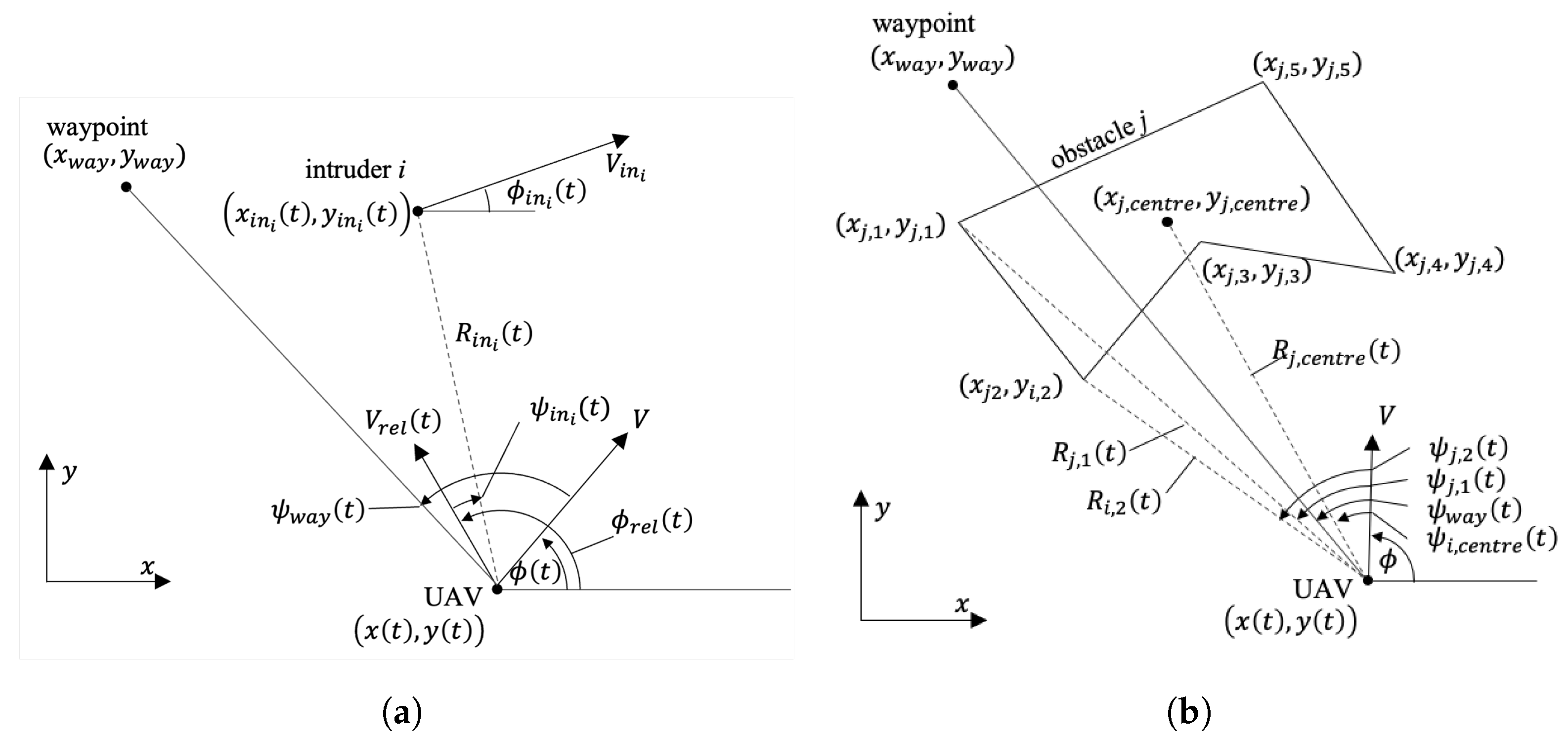

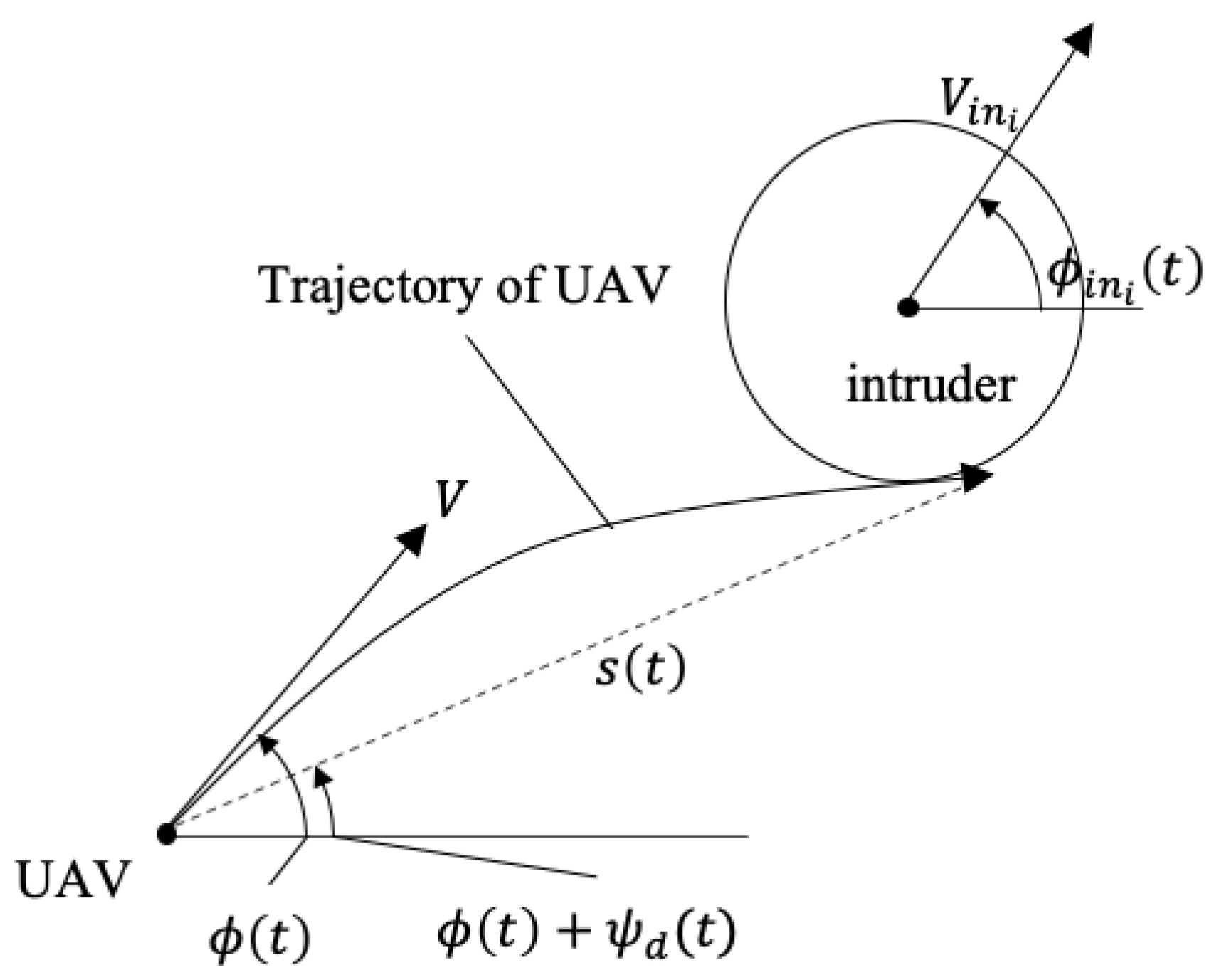
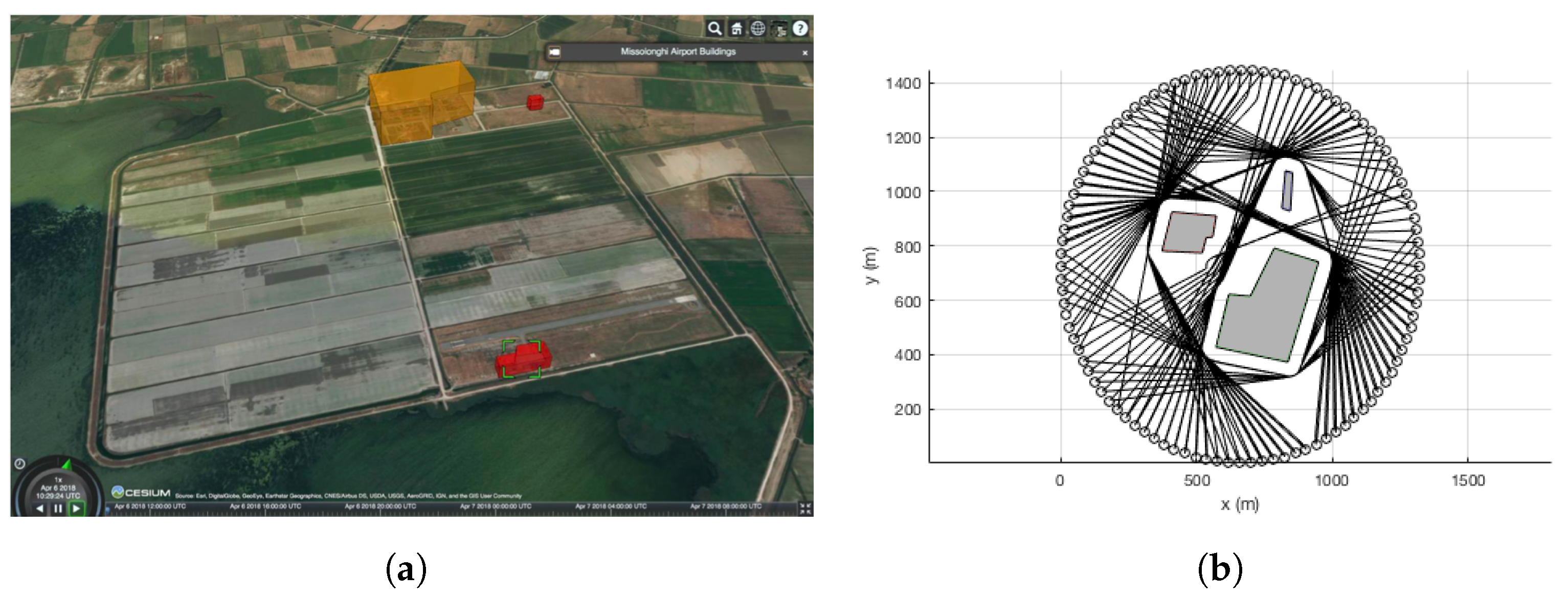
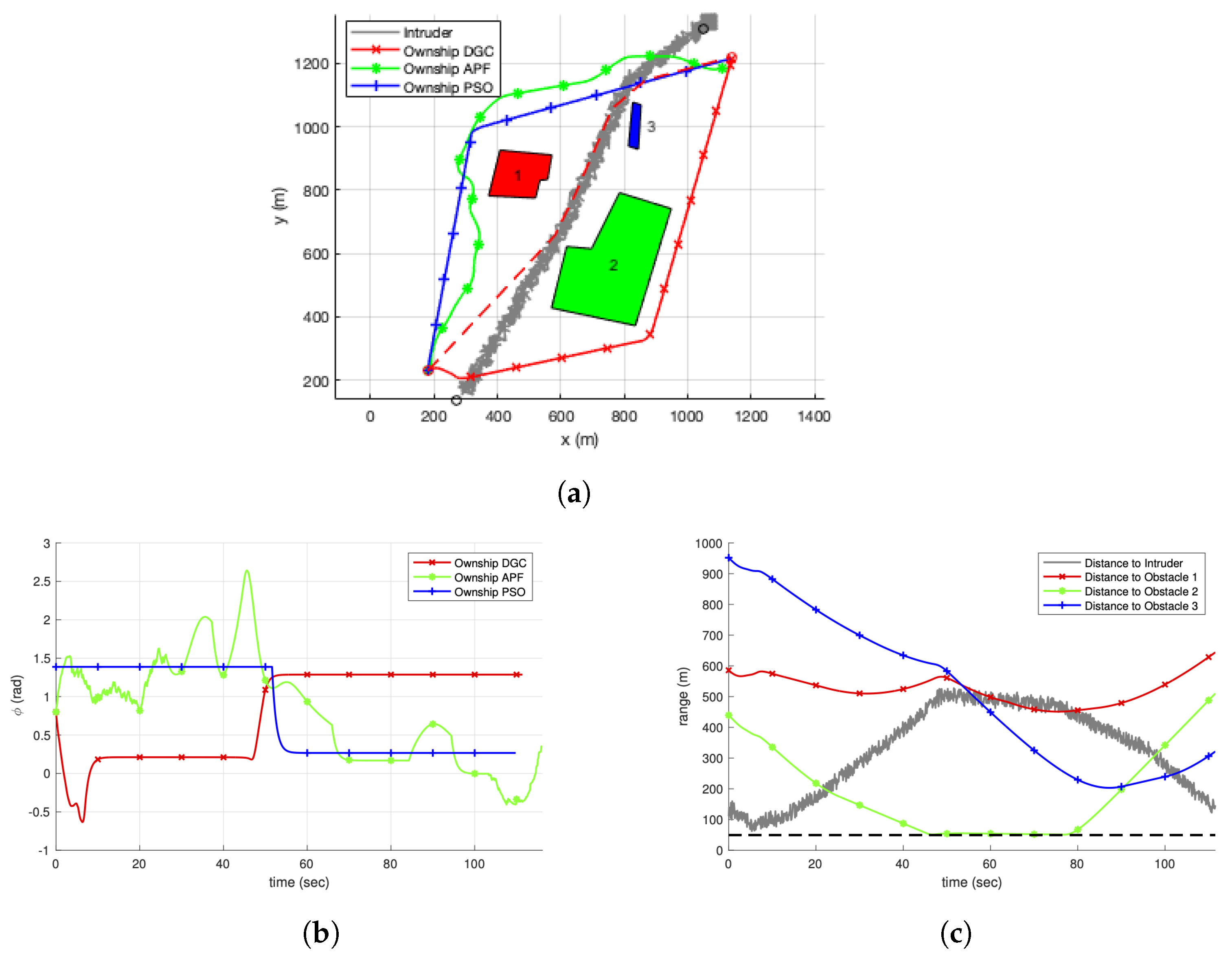
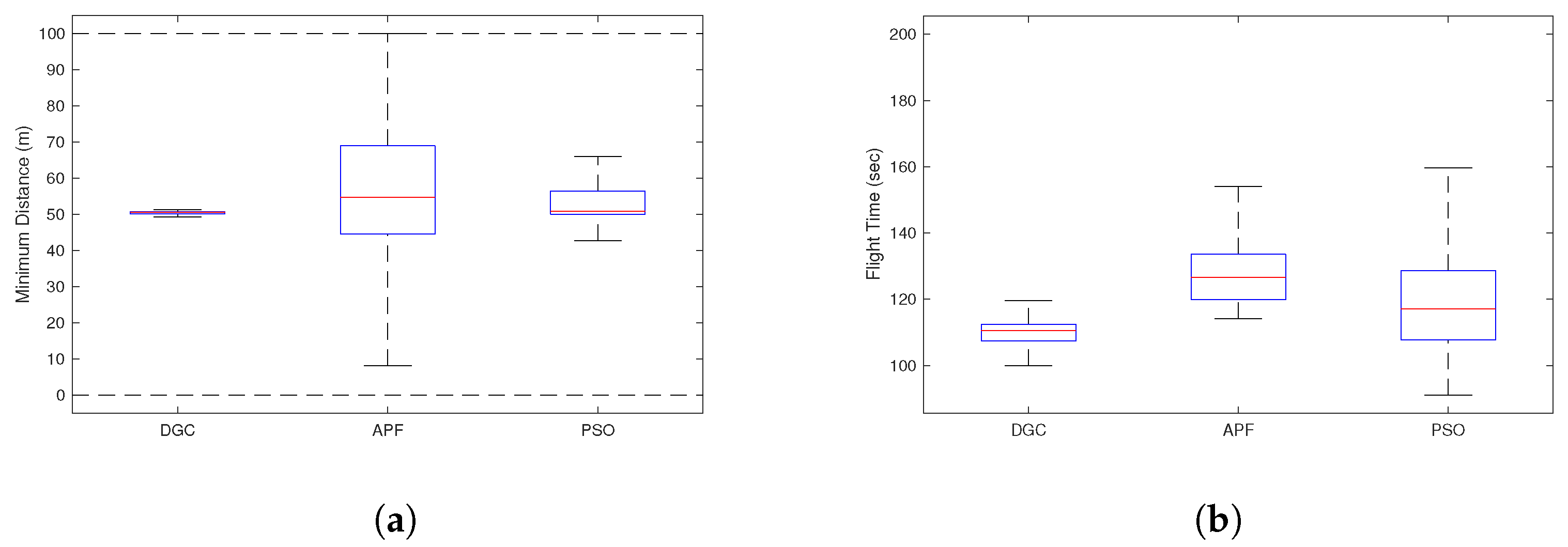

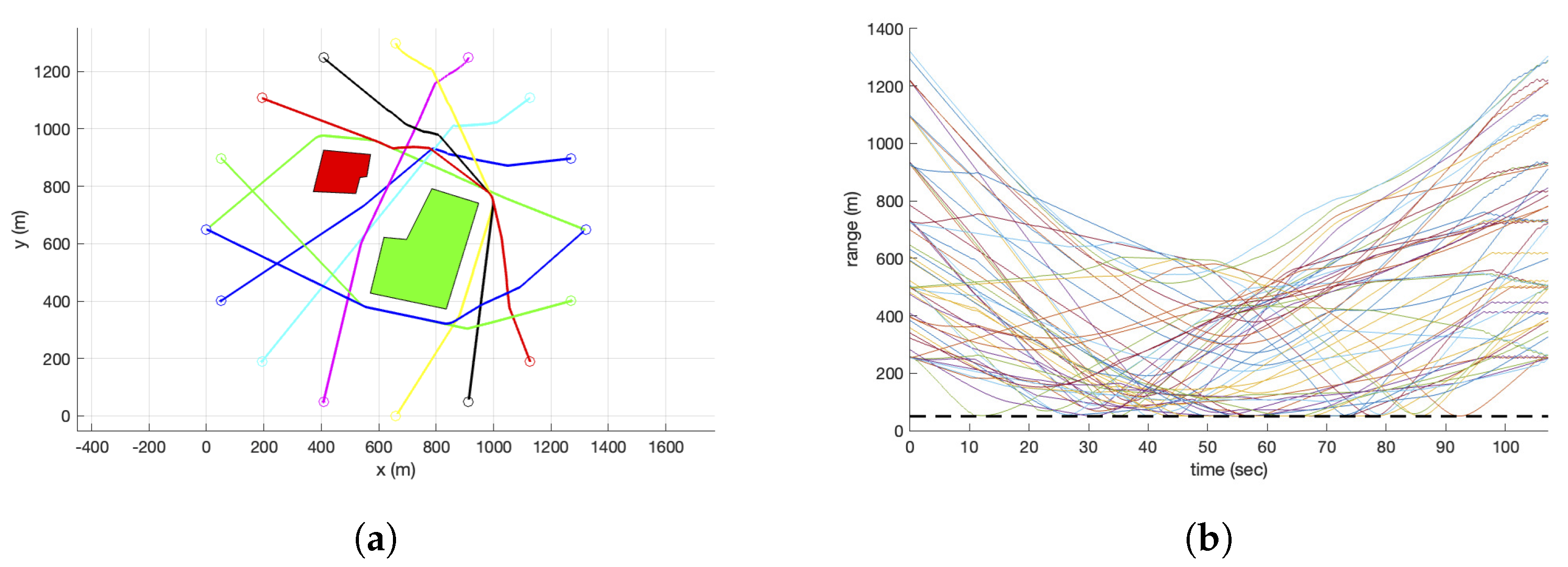
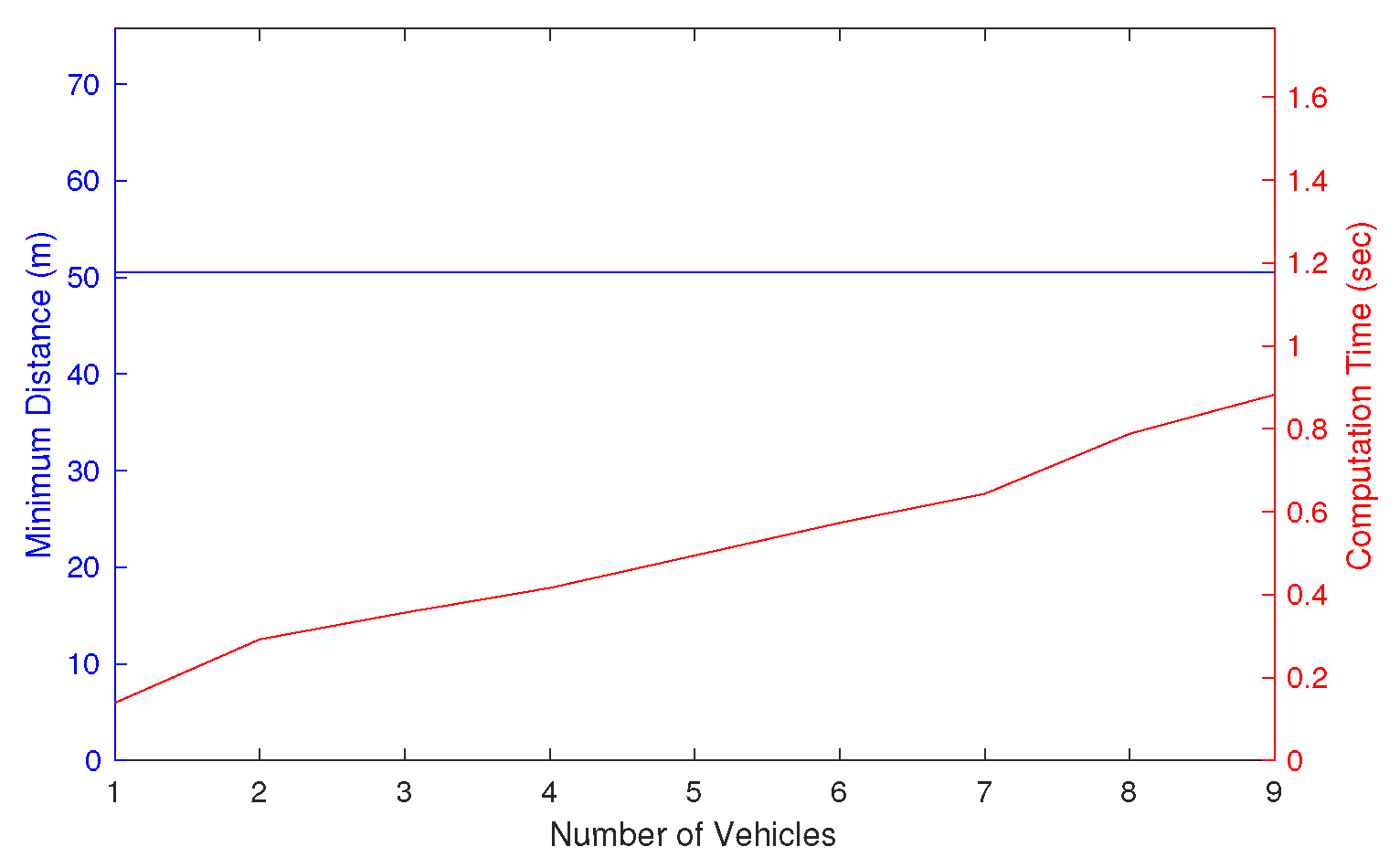
| DGC | APF | PSO |
|---|---|---|
| Safety | Efficiency | Scalability | |
|---|---|---|---|
| (Minimum Distance (m)) | (Total Flight Time (s)) | (Computational Time (s)) | |
| DGC | 49.29–51.34 | 99.9–119.6 | 0.2 |
| APF | 8.21–104.83 | 114.1–154 | 0.1 |
| PSO | 42.77–66.98 | 91–159.6 | 4.6 |
Publisher’s Note: MDPI stays neutral with regard to jurisdictional claims in published maps and institutional affiliations. |
© 2022 by the authors. Licensee MDPI, Basel, Switzerland. This article is an open access article distributed under the terms and conditions of the Creative Commons Attribution (CC BY) license (https://creativecommons.org/licenses/by/4.0/).
Share and Cite
Lee, H.-I.; Shin, H.-S.; Tsourdos, A. A Probabilistic–Geometric Approach for UAV Detection and Avoidance Systems. Sensors 2022, 22, 9230. https://doi.org/10.3390/s22239230
Lee H-I, Shin H-S, Tsourdos A. A Probabilistic–Geometric Approach for UAV Detection and Avoidance Systems. Sensors. 2022; 22(23):9230. https://doi.org/10.3390/s22239230
Chicago/Turabian StyleLee, Hae-In, Hyo-Sang Shin, and Antonios Tsourdos. 2022. "A Probabilistic–Geometric Approach for UAV Detection and Avoidance Systems" Sensors 22, no. 23: 9230. https://doi.org/10.3390/s22239230
APA StyleLee, H.-I., Shin, H.-S., & Tsourdos, A. (2022). A Probabilistic–Geometric Approach for UAV Detection and Avoidance Systems. Sensors, 22(23), 9230. https://doi.org/10.3390/s22239230









